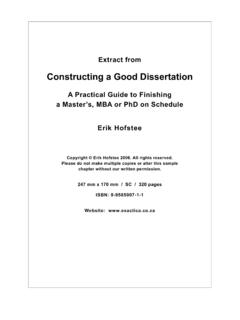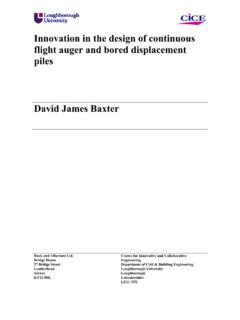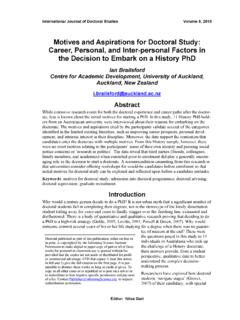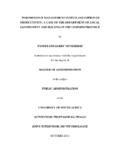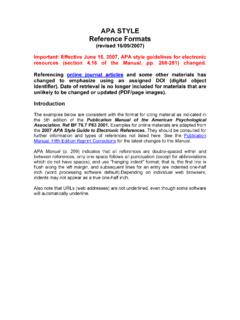Transcription of Constructing a Good Dissertation - Exactica
1 Extract fromConstructing a good DissertationA Practical Guide to Finishinga Master s, MBA or PhD on ScheduleErik HofsteeCopyright Erik Hofstee 2006. All rights do not make multiple copies or alter this samplechapter without our written mm x 170 mm / SC / 320 pagesISBN: 0-9585007-1-1 Website: A man who reviews the old so as to find out the new is qualified to teach others. Confucius CHAPTER 1 THE LITERATURE REVIEW The literature review always comes after the introduction and before the method chapter. This makes sense: In the introduction, you ve told your reader what you re going to do and you ve intrigued them enough to read on. Now it s time to locate them solidly in the secondary literature. The secondary literature is the body of works previously published by other scholars. You need to identify and review those relevant to your work.
2 A good literature review is comprehensive, critical and contextualised. That means that it will provide the reader with a theory base, a survey of published works that pertain to your investigation, and an analysis of that work. It is a critical, factual overview of what has gone before. The literature review is not the place to present research data of your own (unless it has been previously published, that is). It contains secondary sources only. THE PURPOSE OF THE LITERATURE REVIEW A literature review serves several purposes in your Dissertation . A good literature review shows that you are aware of what is going on in the field, and thus your credentials that there is a theory base for the work you are proposing to do how your work fits in with what has already been done (it provides a detailed context for your work) that your work has significance that your work will lead to new knowledge.
3 Let s take them one by one. Your Credentials Readers will not take either you or your work terribly seriously unless you manage to convince them that you are well read in whatever it is that you are investigating. Well read , by the way, means that you have read broadly in your field and that you understand the important works in depth. If your literature review is any good , there T H E D I S S E R T A T I O N 92 PART 2won t be much room left for doubt on either point. By your selection of works, organising them in a way that makes sense, discussing them objectively, and focussing on the important bits, you will have established your credentials. Theory Base This is a part of the literature review that poses a major problem for many students. In it, you need to show that you understand and can relate your work to the major theories that underpin what you are going to do.
4 Look at it this way: If you were developing a new product, paint perhaps, you wouldn t just throw a lot of ingredients together. If you randomly combined sand, bolts, tonic water, flour and paper, you would make a mess, not paint. If, on the other hand, you understood the theory behind what makes paint, you would probably use the key ingredients that the theory predicts would make paint. You would know what they are and why they work. You might add some new ingredients or combine old ones in a new way, but your work would be based on theory. It would have a theory base. On the basis of theory you would be able to explain, before you even made your new paint, why it would be likely to work. The same thing applies to all academic work. For example, it is one thing to devise a new system to teach children to read at an early age; it is another to prove that it works.
5 Assuming that it does work, an explanation of why it works is the theory behind it. There will be certain principles that cause it to work. Naming those will be the basis of the theory. The theory might ultimately be wrong, right, or partially right, but until contradicted by facts it is a possible explanation. If something has no theory base whatsoever for example, using the density of traffic in the morning to predict the yield of next year s maize crop it s unlikely to produce interesting or valid results. If no one has thought of any reasonable explanations for why something might work and you can t either, it probably won t work. A theory base is necessary for readers to take your work seriously. It is possible, even likely, that there will be several conflicting theories about why something is the way it is. For example, there are several competing theories To understand what a theory base is, one needs to understand what the word theory means in academic terms.
6 In popular terms, the word implies fuzziness, guesswork and unreliability. In academic terms, a theory is a logical explanation for why something is as it is or does as it does. Theories are not cast in stone something may come along and disprove them tomorrow but they are the best explanations we currently have. The more general a theory is the more it explains without the facts contradicting it the better a theory it the exact sciences, theories are often testable and have predictive power. In the social sciences and humanities, this is not as often the case, but they are still logical interpretations and explanations that help us make sense of the world around us. T h e L i t e r a t u r e R e v i e w 93accounting for the different roles men and women have played in society, ranging from purely cultural theories to genetic ones, with many variations and spin-offs.
7 If you are required to include a theory base in your Dissertation , you need to hunt down the major explanatory theories that pertain to what you are doing and comment on them as they relate to your work. Do consult with your supervisor when doing this part of the literature review he or she will know the theories and the main players. Context What you need to do here is to locate your work in the work of others. It must be clear to the reader how what you are proposing to do fits in with what has gone before. By discussing the works related to what you re going to do and focussing on the ones most closely related, the context of your work will automatically be clear. This one is closely related to the next point, significance. Significance After reading your literature review, there should be little doubt in readers minds that your work has some significance. You will have gone quite some way towards making the case in your introduction but, by grounding your proposed work in the previous literature, you will show the significance of your work.
8 If you structure your literature review according to the funnel method described below, the significance of your work will emerge automatically. If you want to emphasise the significance and originality of your work, when you review the work of other scholars, gently point out, where you can, omissions or inadequacies in their work as it relates to what is original in your work. Don t do this too often or too blatantly. If you do, it will become transparent and irritating. But you certainly can put in a few well-placed remarks to the effect that while contributing in this and that regard, unfortunately So-and-so s work does not address [your originality] or So-and-so s major contribution was this, that and the other. However, he fails to consider his point in the South African environment [while you do]. Originality If you have reviewed the related work of other scholars and you have not found anything that precisely duplicates what you are going to do, then your work must be original if your literature review has been at all comprehensive, that is.
9 This, incidentally, is one of the reasons why it is so important that your literature review focuses on the most closely related and most current work. It s how you show that what you are planning to do hasn t already been overtaken by work already published. There are exceptions to the originality requirement. For example, if you are precisely duplicating the work of someone else in order to check its validity, obviously there s not much room for originality. Your originality then lies in your T H E D I S S E R T A T I O N 94 PART 2thesis statement only: You will hypothesise that the work either can or cannot be replicated. Similarly, a meta-study also leaves little room for originality. STRUCTURING THE LITERATURE REVIEW Given the number of works that literature reviews can contain and the importance of balance having a good structure for your literature review is vital.
10 The funnel method will bring order to your literature review. It will also make it much easier to write because it provides you with a built-in structure. Categorising Works The first rule of the funnel method is to group works by commonality. This applies regardless of topic or thesis statement. It does not matter if you include articles, books or any other type of secondary sources in a group: If they have something in common, they should be grouped together. There is no formula for what commonalities you should choose, or into how many groups you separate the works. Whatever seems to you to link works together is what you should choose. They could be linked by the focus of works or by how they relate to major facets of your work. Whatever substantial similarities you find are potential groups. One of the groups should, however, should be Theory Base . Be sure to use your index cards when grouping the works.



